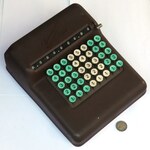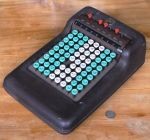

The Dacometer 508
Video
The Dacometer 908
Video
History
Models
Advertisements and Articles
Patents
Links
The Dacometer 508 is quite a rare key-driven adding machine with a
half-sized keyboard, similar to the earliest Bell Punch
Plus Adder or the Contex A or B. It has 8 columns
of keys, and a 9-digit register that is located beyond the keyboard. When you
press a key, the chosen digit is added to the register immediately. This happens
during the downstroke of the key, and partial keystrokes will cause only part of
the digit to be added leading to incorrect results. To the right
of the register is a clearing lever. After clearing the register, the clearing
lever stays in the down position. It pops back up the first time a key is pressed,
triggering a bell.
It has serial number 3411, and was made in about 1951 in Copenhagen, Denmark
by Rich. Müller A/S, and distributed by Dacorema A/S.
The vertical movement of a key is converted to a horizontal movement through a bellcrank, an L-shaped lever, where keys of different values have differently proportioned levers. The horizontal movement of a rod is then converted via a toothed rack to a rotation of a number wheel. A second horizontal rod is moved at the end of a keystroke and activates a brake to prevent the wheel from overshooting.
The carry mechanism is quite interesting. When a number wheel turns it winds a spring, and when the wheel rolls over to zero a catch is released so that the spring rotates an axle through a full rotation. This rotation is reduced by a 10:1 ratio and turns the next wheel one step. The interesting part is that the 10:1 reduction is done by an excentric gear system. There is a 9-toothed excentric gear with a fixed orientation. It is surrounded by a 10-toothed ring fixed to the number wheel. The driving axle pushes the excentric gear around the ring once, thereby moving the ring forward by one tooth. It is also constructed in such a way that the carry can be performed even if the receiving wheel is being rotated due to a key press, because the gearing acts like a differential gear system.
Here is a video where I demonstrate my Dacometer 508.
The Dacometer 908 is a rare key-driven adding machine with a full keyboard, similar to the
Burroughs Calculator. It has 8 columns of keys, and a
9-digit register that is located beyond the keyboard. When you press a key, the chosen digit
is added to the register immediately. This happens during the downstroke of the key, and
partial keystrokes will cause only part of the digit to be added leading to incorrect results.
Above the register is a row of carry suppression buttons which are used in subtraction, which
is done using complementary digits. To the right of the register is a clearing lever. After
clearing the register, the clearing lever stays in the down position. It pops back up the
first time a key is pressed, triggering a bell.
It has serial number 5348, was made in about 1951 in Copenhagen, Denmark by Rich. Müller A/S,
and distributed by Dacorema A/S. On the rear is a faded decal of the logo of The Imperial
Import Company of Amsterdam.
On this machine the carry springs are broken on two of the number wheels (the third and sixth from the right). I am not able to disassemble the register without disassembling the whole mechanism, so am unable to repair it easily. Those same springs are used in the clearing mechanism too, so those two wheels do not clear properly.
Here is a video where I demonstrate my Dacometer 908.
The company Rich. Müller A/S was founded in 1901 by Richard Müller. He was a German
toolmaker who had emigrated to Denmark a few years earler. After his death in 1925, his son
Ernst Müller took over. The company made a variety of things made from metal. Between
1947 and about 1955 they made a series of mechanical calculators.
Dacorema A/S seems to be an independent company that sold office equipment, and they had exclusive
rights to market these Dacometer calculators during the 7 or 8 years that they were made.
It is unclear what relationship these two companies had, other than both being based in
Copenhagen, but it is notable that Dacorema registered Dacometer as a trademark 3 years
before the machine came to market.
The Rich. Müller company still exists today as RMIG (Richard Müller International Group) and is specialised in making perforated metal sheets. Dacorema seems to have ended in the mid 1970s.
There were two main types of Dacometer. One type had a half-sized keyboard, while the other had a full-sized keyboard with carry suppression buttons. The table below lists the variations that these two types went through. The serial number ranges are based on known serial numbers taken from various online sources.
| Years | Half-size keyboard | Full-size keyboard |
|---|---|---|
| 1947-1949 | Dacometer 5 Ser. No: 1148-2522 |
Dacometer 98 Ser. No: 5039-5161 |
8-column keyboard, 9-digit register Boxy black or dark brown bakelite case Works on downstroke Serial numbers probably started at 1000 and 5000. There was also the Dacometer 9 which was identical to model 98 except that it had some kind of extra register in front of the keyboard (possibly to show the last keypress in each column), but it was much more expensive, and therefore rarer. I found a Norwegian newspaper ad that includes this model so it was sold commercially, but have not found any still existing examples of the machine online. |
||
| 1950-1952 | Dacometer 508 Ser. No: 2845-3411 |
Dacometer 908 Ser. No: 5348-5382 |
8-column keyboard, 9-digit register Rounded brown steel case (possibly some in bakelite) Works on downstroke Serial numbers probably follow on from the previous model. |
||
| Dacometer 511 Ser. No: 4023-4396 |
Dacometer 911 Ser. No: 10077-10170 | |
11-column keyboard, 12-digit register Rounded brown steel case (possibly some in bakelite) Works on downstroke Serial numbers probably started at 4000 and 10000. |
||
| 1952-1955 | Dacometer 508 Ser. No: 15112-15765; 30305-31470 | |
8-column keyboard, 9-digit register Rounded green-grey steel case Works on upstroke Serial numbers probably started at 15000 and 30000. It is unclear whether the jump to a new range of serial numbers introduced any other changes. Also rebranded by Torpedo as "Torpedo Schnelladdiermaschine" from 1952. Previously Torpedo made licensed copies of the Bell Punch Plus adders (or their predecessor, the Petometer). |
||
The Dutch book "Efficiency op kantoor" from 1949 has photos and short descriptions of the Dacometer 5 and 9.
I found a few text-only advertisements in Dutch newspapers, and a nice one with a picture in an Australian newspaper.
Here are some Dacorema trademarks, shares notices and other records found in the Danish royal library.
The mechanism of the Dacometer 9 is almost identical to the one described in a patent by George C.
(Clinton) Chase from 1915. The patent references J.A. Turck's calculator, the Mechanical Accountant as its
reference point, and improves on it by having a carry mechanism that works even when the receiving
wheel is being turned by a key press. The patent also describes the rest of the mechanism,
including the carry suppression buttons, the keyboard and actuating mechanism, and clearing
mechanism, all of which were used in the Dacometer. He also had an earlier patent which
describes a carry mechanism that uses a planetary gear system.
By 1930 George C. Chase was working for Monroe, where he became
the chief designer.
| Patent | Filing date | Priority date | Name | Description |
|---|---|---|---|---|
| US 1,011,156 | 29-06-1911 | 12-12-1911 | George C. Chase | Registering Mechanism for Calculating-Machines |
| US 1,329,262 | 20-03-1915 | 27-01-1920 | George C. Chase | Calculating-Machine |
© Copyright 2020-2021 Jaap Scherphuis, mechcalc a t jaapsch d o t net.